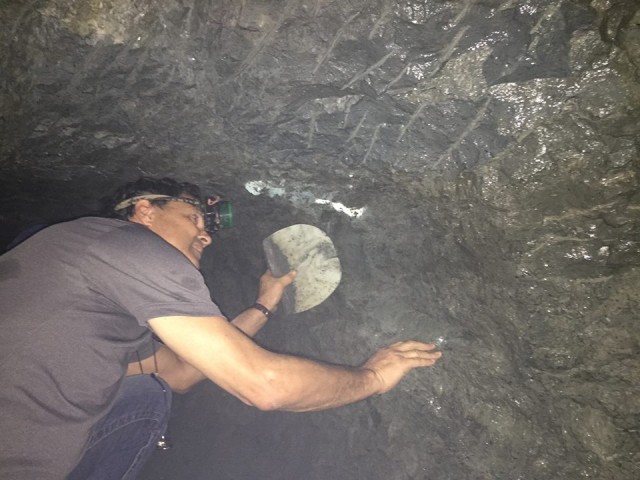
Indonesische opaal - een veldrapport door Paul Sedawie
 Ik bezocht een nieuwe opaalmijn in Banten, net buiten Jakarta, Indonesië. Opaal werd hier in 1995 ontdekt en sindsdien zijn er verschillende productieniveaus geweest.
Ik bezocht een nieuwe opaalmijn in Banten, net buiten Jakarta, Indonesië. Opaal werd hier in 1995 ontdekt en sindsdien zijn er verschillende productieniveaus geweest.
Er zijn drie hoofdgebieden waar de nieuwe Opal te vinden is.
- 1.Cikole - Maja
- 2.Rangkas - Bitung
- 3.Cikole
In het Cikole-gebied zijn veel fossiele houtsoorten te vinden. Momenteel zijn er zo'n dertig ploegen aan het werk, en ze lijken zich te verplaatsen en geen lange ritten te maken. De eerste mijn die ik bezocht, was een ondiepe mijn van slechts 12 meter. Het ligt in een gebied met veel regenval, dus de meeste mijnbouw vindt plaats in het droge seizoen, vanaf juli. De bovenkant van de mijn werd ondersteund door bamboe, wat me niet sterk leek, en de rieten ladder was niet breed genoeg voor een van mijn voeten.


De wanden waren verzadigd met water en er stroomde bijna een beekje aan de voet van de schacht. Toen werd mij verteld dat er vorig jaar twaalf mijnwerkers waren omgekomen door instortende wanden. De wanden zijn niet gestut of ondersteund, en zijn zelfs diep in de mijn erg vochtig. De grond is een zware, kleverige kaolinietklei met een grijs tot bruin uiterlijk, met overal zwarte, houtskoolachtige vlekken. Ze volgen de verschuivingen in de grond die de neiging hebben om opaal te vormen.

Er lijkt een overvloed aan fossiel houtopaal te zijn, dat gitzwart van kleur is. Sommige natuurlijke ruwe opalen droogden sneller uit na bevochtiging, wat vrij ongebruikelijk is omdat ik gewend ben met Lightning Ridge-materiaal te werken. Het fossiel hout leek stabiel, maar de kristallen waren erg hydrofaan. Het materiaal lijkt broos, net als yowah-stenen, en is zachter om te bewerken dan Ridge-materiaal. Er is een juweliersmarkt in Jakarta waar mijnwerkers hun producten kunnen verkopen.
Waargenomen opaalbehandelingen
Er worden grote platen zwarte potch tentoongesteld, maar die zijn gedrenkt in glycerine. Zelfs grote zwarte rubs zijn erin gedrenkt. Het lijkt erop dat dit een gebruikelijke praktijk is om de meeste materialen te weken. Er zijn ruwe sieraden gemaakt van onedele metalen en ook die zijn in babyolie gedrenkt. Zelfs goede stenen bevatten babyolie en ik schrijf dit toe aan het feit dat de afwerking niet commercieel is, waardoor de olie eventuele putjes, krassen, enz. verbergt. Er bestaat een warmtebehandeling voor houtfossielen waarbij ze het exemplaar in folie wikkelen en verhitten met olie en zand en dit mengen. Het succespercentage is niet erg hoog, maar ze krijgen wel een leuke verrassing met sommige materialen. Sommige potch heeft de klei stevig aan zich vastgehecht en door de hitte verdwijnt die.

Momenteel heb ik het gevoel dat de olie de opaalkleur tot leven brengt en dat er hars aan wordt toegevoegd om de glans te behouden. De snijvaardigheden van de lokale bevolking zijn niet zo goed en ik vermoed dat ze olie en hars gebruiken om een afwerking te krijgen. Ik ga wat houtfossielen testen in een vibrerende trommel voor een betere permanente afwerking. Een andere behandeling is natuurlijke hitte. Hierbij wordt een steen in water gelegd en een week lang in de zon gelegd, zonder andere ingrediënten.
Ze zeggen dat het de donkerheid van de steen verbetert, maar ik heb er een paar doormidden gezaagd en zie geen verschil binnenin. Er zijn een paar prachtige fossielen van geopaliseerd hout die geweldige verzamelobjecten vormen. Sommige van die geopaliseerde houtsoorten zijn geweldige stenen. Deze opaal houdt van fel zonlicht en kan er prachtig uitzien, maar bij weinig licht is er weinig kleurspel. Stenen met rood erin komen veel voor, maar de meeste zullen ver weg en een beetje loodachtig zijn.

Conclusies
Nog steeds een geweldige ervaring voor een hobbysnijder om een rood-op-zwarte steen te snijden. Ik zag wel een zeer opvallende steen van 7 jaar oud, die rood en indrukwekkend was, maar ik zag hem niet bij weinig licht. De onderkant was gitzwart.
De meeste ruwe stenen die ik zag, zouden geclassificeerd kunnen worden als N1 tot N3, maar de helderheid bij normale bliksem is ver weg/dof. Er is zeker een markt voor deze opaal. Ik vermoed dat sommige hydrofaan zijn en dat sommige ruwe stenen snel uitdrogen. De kristallen zien er interessant uit, maar ik heb slechts een paar kristalstenen gezien waarvan werd gezegd dat ze een paar jaar oud en stabiel waren.
Ik heb monsters naar een gerenommeerd wetenschapper gestuurd die gespecialiseerd is in opaal om deze te testen en zal deze aan dit rapport toevoegen. Blijf op de hoogte.
Koop uw eigen stuk Indonesische opaal
Zoek de Opal Encyclopedia
Gerelateerde veilingen
gerelateerde artikelen
De geboortesteen voor oktober is onze favoriete edelsteen, de opaal. Zwarte opalen, Mexicaanse opalen en Ethiopische opalen zijn allemaal net zo uniek als de mensen die in oktober zijn geboren
3rd Oct 2019
Er zijn zoveel Queensland Opaalmijnen verspreid over 1000 km². Klik om meer te weten te komen over elke locatie en bekijk onze prachtige Queensland Opalen te koop.
5th Mar 2019
Laatste artikels
Zwarte opalen zijn de meest gewilde opaalsoort, met een diepe basis die een regenboog aan reflecties creëert. Ontdek de toepassingen, eigenschappen, geschiedenis en waarde van zwarte opalen!
7th Dec 2025
Ontdek hoe opalen worden beoordeeld en welke factoren hun prijs beïnvloeden. Van kleur en helderheid tot slijpvorm en oorsprong, leer hoe elk type opaal wordt gewaardeerd - met voorbeeldprijsklassen.
19th Jul 2023
Ga mee op reis en leer over de helende kracht van opalen van onze gastschrijver Vivien Schapera van Crystal Healing Techniques!
20th May 2023
Artikelcategorieën
All there is to know about Opals including Black Opals, Ethiopian Opals & Boulder Opal
14 Artikelen
Check out our fascinating information and articles on all things amazing in the Opal world
41 Artikelen
Opal Auctions sellers who are approved as opal Verified Sellers
4 Artikelen





